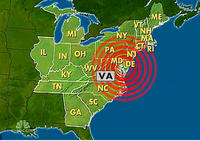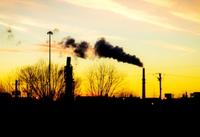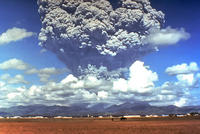-
Last year’s east coast earthquake has the region preparing for another one

Last year an earthquake that was centered in Virginia shook up the entire east coast, surprising everyone; it did not result in any deaths and was considered relatively light compared to many tremors on the West Coast, but it was bad enough to force some states to prepare themselves in case of another quake
-
-
Activists in arms over plans to ship plutonium to New Mexico
A proposal to ship tons of plutonium to New Mexico, including cores of nuclear warheads which would be dismantled at a structurally questionable lab on top of an earthquake fault zone, has activists and nuclear watchdogs up in arms
-
-
Tampa Bay’s infrastructure receives C grade – some say it is a gentleman’s C

All eyes are Tamp Bay as it anxiously awaits the full brunt of tropical storm Isaac; long-time residents of the city and the neighboring counties will not be happy to learn that the city has been given a C grade for its infrastructure; engineer Kathy Caldwell, past president of the American Society of Civil Engineers, who teaches at the University of Florida, said: “None of us would expect our children to come home with the reports cards that we gave the region’s infrastructure”
-
-
Crowdsourcing for quake-monitoring
Technology is creating a new breed of scientist — citizen scientists – ordinary people and volunteers from all walks of life coming together to help monitor, and possibly mitigate, the next big earthquake through an innovative program called NetQuakes
-
-
Cooling coal emissions would clean air, lower health, climate-change costs

In the United States there are about 1,400 electric-generating unit powered by coal, operated at about 600 power plants; the estimated health costs of burning coal in the United States are in the range of $150 billion to $380 billion, including 18,000-46,000 premature deaths, 540,000 asthma attacks, 13,000 emergency room visits, and two million missed work or school days each year; scientists estimate that implementing large-scale cryogenic systems into coal-fired plants would reduce overall costs to society by 38 percent through the sharp reduction of associated health-care and climate-change costs
-
-
Maldives to build floating islands to save country from rising sea levels
The Maldives Islands, a low-lying chain of twenty-six atolls in the Indian Ocean, are sinking; more precisely: due to global warming, the sea level is rising over the islands, most of which sit lower than three feet above the rising water; the Maldives government has embarked on an ambitious project: build floating islands, anchor them to the ocean floor, then relocate most of the population of 300,000 – and some of the tourist attractions – to them
-
-
New hurricane simulator to help find way to minimize storms’ destruction
Hurricanes in Miami can range from just rain and light wind to shredded houses, overturned cars, massive flooding, and death. Now, almost twenty years after Hurricane Andrew, Florida International University is using a new simulator to find ways to prevent the massive damage a hurricane can create
-
-
Explaining the scale of Japanese tsunami

Tsunamis are caused by earthquakes under the seabed; some tsunamis, including the disaster that hit Japan last year, are unexpectedly large; scientists suggest that their severity is caused by a release of gravitational energy as well as elastic energy
-
-
Electric plants challenged by high temperatures, drought
The hottest July on record since 1895, along with the most wide-spread drought in the country since 1956, have nuclear plants struggling with finding enough water — cool water — to keep key parts of the plants cool; if the water gets too warm, operators have to dial back production — for reactor safety, and also to regulate the temperature of discharge water, which affects aquatic life
-
-
No-till could help stabilize crop yields despite climate change
Reducing tillage for some Central Great Plains crops could help conserve water and reduce losses caused by climate change, according to studies at the U.S. Department of Agriculture
-
-
Home, office WiFi could be used by emergency responders
Wireless routers for homes and offices could be knitted together to provide a communications system for emergency responders if the mobile phone network fails
-
-
Drone use spreads to more areas and missions

As security challenges in the United State and around the globe change, many countries have one thing in common: unmanned drones will be a significant part of the future of security; advancements in technology are driving the use of UAVs into newareas
-
-
World could be in for higher food prices
This has been one of the driest summers in American history, but the weather is not only affecting the United States; weak monsoons in India and other weather issues across the globe are affecting crops and could lead to higher food prices in 2013
-
-
Geoengineering clouds to slow global warming

Researchers are taking a second look at the possibility of using futuristic ships to shoot salt water high into the sky over the oceans, creating clouds that reflect sunlight and thus counter global warming; The theory behind idea, called “marine cloud brightening,” is that adding particles, in this case sea salt, to the sky over the ocean would form large, long-living clouds
-
-
Greenland melting breaks record four weeks early – with two weeks more to go
Melting over the Greenland ice sheet shattered the seasonal record on 8 August — a full four weeks before the close of the melting season; with more melting yet to come in August, this year’s overall melting will fall way above the old records; researchers devise a “cumulative melting index,” which measures the type of melting which adds to the runoff of melt-water that makes sea levels rise
-
More headlines
The long view
Using Drone Swarms to Fight Forest Fires
Forest fires are becoming increasingly catastrophic across the world, accelerated by climate change. Researchers are using multiple swarms of drones to tackle natural disasters like forest fires.
How Climate Change Will Affect Conflict and U.S. Military Operations
“People talk about climate change as a threat multiplier,” said Karen Sudkamp, an associate director of the Infrastructure, Immigration, and Security Operations Program within the RAND Homeland Security Research Division. “But at what point do we need to start talking about the threat multiplier actually becoming a significant threat all its own?”
